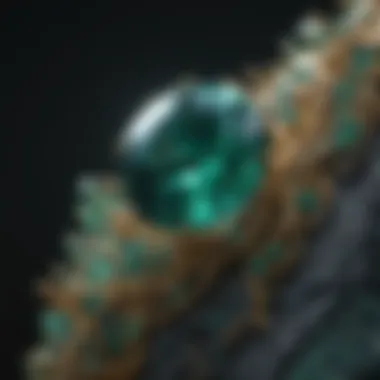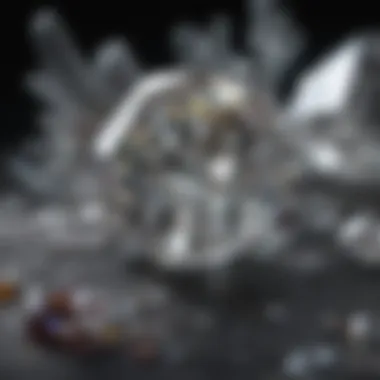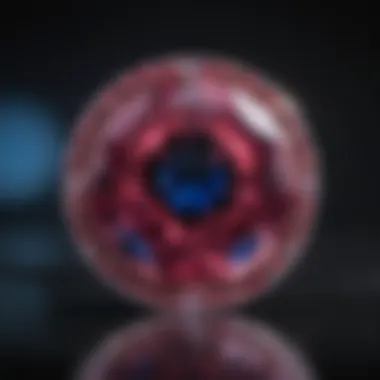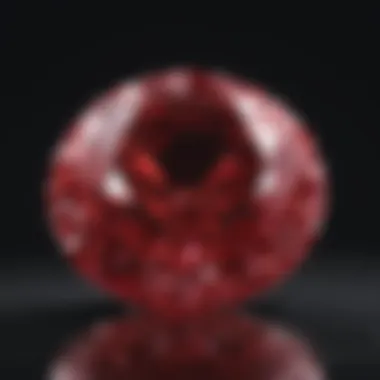Unveiling the Intricacies of Gemstones Through a GIA Microscope


Overview of Gemstones and Minerals
Gemstones have a rich history steeped in ancient traditions and legends, with their origins dating back centuries across various cultures worldwide. Valued for their inherent beauty and perceived mystical properties, gemstones have held significant importance in society and commerce. From the symbolism associated with birthstones to the luxury status of rare gems, the allure of gemstones transcends time and geography.
Gemstone Formation and Properties
The formation of gemstones is a geological marvel, involving a complex process deep within the Earth's crust under high pressure and temperature conditions. This transformative journey typically begins with mineral elements crystallizing over millions of years to create the vibrant hues and intricate patterns that define each gemstone. Additionally, gemstones possess unique physical properties such as color, hardness, and luster, which are instrumental in distinguishing one gem type from another.
Types of Gemstones
Gemstones are broadly categorized into precious and semi-precious varieties based on rarity, historical significance, and market demand. While precious stones like diamonds, rubies, sapphires, and emeralds command high value and appeal, semi-precious gemstones such as amethyst, topaz, and citrine offer a wider range of colors and affordability. Furthermore, the world of gemstones extends to exotic and rare specimens like alexandrite, tanzanite, and paraiba tourmaline, coveted for their limited availability and unmatched beauty.
Identifying and Evaluating Gemstones
The value of a gemstone is determined by a myriad of factors including carat weight, cut quality, clarity, and color intensity. Gemologists utilize advanced techniques and tools, including the GIA microscope, to accurately identify and assess the quality of gemstones. By examining internal characteristics, light behavior, and optical properties, experts can evaluate the authenticity and craftsmanship of each gemstone, ensuring transparency and quality standards in the industry.
Caring for Gemstones
Proper care and maintenance are essential in preserving the brilliance and longevity of gemstones. Cleaning gemstones with mild soapy water and a soft brush, followed by gentle drying with a lint-free cloth, helps maintain their natural radiance. To prevent damage, storing gemstones separately from other jewelry in padded containers or cloth pouches is advised. Additionally, specific gems like opals and pearls require special attention due to their delicate nature, necessitating gentle handling and storage away from harsh chemicals or extreme temperatures.
Introduction
Gemstones have captivated humanity for millennia, their allure transcending time and culture. The Introduction sets the stage for our journey into the mesmerizing world of gemstones under the lens of a GIA microscope. It sheds light on the importance of understanding the intricate details hidden within these natural treasures, emphasizing the role of advanced technology in unraveling their mysteries. By delving deep into gemstones, we embark on a quest to appreciate the beauty and complexity that lie beneath the surface.


Understanding Gemstones
The allure of gemstones
The allure of gemstones lies not only in their exquisite beauty but also in the stories they carry within their depths. Each gemstone possesses a unique charm that draws admirers and collectors alike. From the vivid hues of a ruby to the dazzling sparkle of a diamond, gemstones spark a sense of wonder and sophistication. Their allure stems from a combination of rarity, durability, and aesthetic appeal, making them a prized choice for jewelry connoisseurs and enthusiasts seeking to adorn themselves with timeless elegance.
The role of gemologists
Gemologists play a crucial role in unraveling the mysteries of gemstones, blending science and art to unveil their hidden secrets. Through meticulous analysis and expert knowledge, gemologists identify and classify gemstones based on their physical and optical properties. Their keen eye and technical skills help in determining the authenticity and quality of gemstones, safeguarding buyers from counterfeit or synthetic alternatives. The role of gemologists is indispensable in the world of gemstones, ensuring that each precious stone is recognized and appreciated for its true value.
The Significance of GIA Microscope
Unveiling Hidden Details
High precision of GIA microscope
The high precision of the GIA microscope is a key factor that sets it apart from conventional microscopes. Its optical design allows for unparalleled clarity and sharpness in viewing gemstone characteristics. Gemologists rely on this precision to detect even the tiniest inclusions or imperfections within gemstone structures. This level of detail aids in accurate grading of clarity and assessment of gem quality. The GIA microscope's precision enhances the overall gemstone analysis process, enabling gemologists to make informed decisions based on reliable observations.
Moreover, the high precision ensures consistency in gemstone evaluations, essential for establishing standardized grading criteria across the industry. Gemstone enthusiasts value the GIA microscope's accuracy in revealing intricate features that enhance their appreciation of gem beauty and rarity. While utilizing the GIA microscope for gemstone examination, researchers and collectors can trust in the instrument's meticulous precision to reveal the true essence of each gem, unlocking a world of hidden marvels.
Advanced magnification capabilities
The GIA microscope's advanced magnification capabilities offer gemologists a detailed view of gemstone properties that is unparalleled. With varying magnification levels, from 10x to 100x or even higher, this instrument allows for in-depth analysis of gem characteristics. The advanced magnification capabilities of the GIA microscope play a crucial role in identifying distinctive features such as color zoning, growth patterns, and identifying treatments or enhancements present in gemstones.
In gemological examinations, the ability to magnify gemstones to such levels enables precise assessment of their structural integrity and optical performance. This feature is particularly valuable in evaluating rare or valuable gemstones where even minor details can significantly impact their value. The advanced magnification capabilities of the GIA microscope empower gemologists to uncover subtle nuances within gemstones, fostering comprehensive understanding and accurate identification. Despite the complexities of gemstone structures, the GIA microscope's magnification capabilities offer clarity and insight that are indispensable in gemstone analysis and appraisal.


Exploring Gemstone Formation
In this section, we will delve into the crucial aspects of gemstone formation, shedding light on the intricate processes that result in these exquisite natural wonders. Understanding the formation of gemstones is paramount in grasping their beauty and value. By exploring gemstone formation, we can gain insight into the geological forces at play and the fascinating journey that transforms minerals into dazzling gemstones.
Insights into Geological Processes
Crystallization and Metamorphism
Crystallization and metamorphism are fundamental processes in the creation of gemstones. Crystallization involves the solidification of minerals from liquid or gas states, forming the crystalline structures that define gemstones' visual appeal. Metamorphism, on the other hand, refers to the changes in a mineral's composition and structure due to intense heat and pressure within the Earth's crust. These processes imbue gemstones with unique patterns, colors, and textures, making them highly sought after in the jewelry industry.
Crystallization and metamorphism play a critical role in shaping gemstone characteristics. The precision and intricacy of crystalline formation determine a gemstone's clarity, while metamorphic transformations contribute to its vibrant hues and luster. These processes are essential to this article as they underpin the authenticity and value of gemstones examined through a GIA microscope.
Environmental Factors Shaping Gem Formation
Environmental factors significantly influence the formation of gemstones, reflecting the specific conditions under which they develop. Factors such as temperature, pressure, and chemical composition of the surrounding materials play a vital role in dictating the crystalline structure and coloration of gemstones. Understanding how environmental conditions shape gem formation provides key insights into their rarity, durability, and overall quality.
The interplay between environmental factors and gem formation is evident in the distinct characteristics exhibited by different types of gemstones. For instance, the presence of certain minerals or impurities in the surrounding environment can imbue gemstones with distinct colors or optical properties. By elucidating the impact of environmental factors on gem formation, this article aims to showcase the dynamic relationship between nature and the creation of these prized geological treasures.
Analyzing Gemstone Properties
Gemstone analysis is a crucial aspect of this exploration. By scrutinizing the properties of gemstones through the lens of a GIA microscope, we gain invaluable insights into their composition and characteristics. Understanding gemstone properties allows us to appreciate their allure and uniqueness fully. Whether it's examining color intensity, clarity, or refraction qualities, each aspect plays a significant role in determining the value and aesthetic appeal of a gemstone.
Revealing Unique Characteristics
Color Intensity and Clarity


Color intensity and clarity are key considerations when evaluating gemstones. The vibrancy of color and the level of transparency not only enhance the gem's visual appeal but also indicate its quality and rarity. Gemologists rely on these factors to assess gemstone authenticity and value. Color intensity can range from subtle pastels to deep, vivid hues, each conveying a different mood and impression. Clarity, on the other hand, reflects the presence of any imperfections or inclusions within the gemstone, influencing its overall brilliance and visual purity. Striking the right balance between color intensity and clarity is essential for creating visually stunning gemstone jewelry.
Refraction and Dispersion Qualities
The refraction and dispersion qualities of a gemstone dictate its brilliance and fire, making it a standout feature in jewelry design. Refraction refers to how light bends as it enters and exits the gem, creating dazzling visual effects. A gemstone's dispersion ability, known as 'fire,' produces spectral colors when light is dispersed into its component hues. These properties are particularly significant for gemstone connoisseurs and enthusiasts seeking gems with exceptional sparkle and light play. By harnessing the refraction and dispersion qualities of gemstones, jewelry designers can craft pieces that capture and reflect light in mesmerizing ways.
Identification Techniques with GIA Microscope
Precision in Gemstone Identification
Inclusion analysis
Inclusion analysis serves as a cornerstone in the realm of gemstone identification, offering valuable insights into the internal characteristics of a gem. By scrutinizing the inclusions within a gemstone, gemologists can make informed decisions regarding its authenticity and quality. The unique feature of inclusion analysis lies in its ability to provide a window into the gemstone's history, revealing any internal imperfections or identifying features that authenticate its origin. While inclusion analysis empowers gemologists with critical information, it also presents challenges such as identifying natural inclusions from artificially added ones, requiring a keen eye and detailed analysis for accurate results.
Enhanced clarity grading
Enhanced clarity grading plays a pivotal role in gemstone identification by evaluating the level of clarity present in a gem. This aspect focuses on assessing the transparency and presence of inclusions within a gemstone, aiding in its categorization and valuation. The key characteristic of enhanced clarity grading lies in its ability to enhance the overall visual appeal and value of a gem, providing buyers with essential information regarding the gem's clearness and purity. While enhanced clarity grading offers significant benefits in gemstone evaluation, it also poses challenges such as subjective interpretations of clarity levels and the potential impact of treatments on the gem's appearance, necessitating a comprehensive approach to maintain accuracy in grading.
Application in Jewelry Design
Gemstones play a pivotal role in the world of jewelry design, elevating pieces from mere accessories to stunning works of art. The use of a GIA microscope in examining gemstones for jewelry design purposes ensures the selection of the finest and most exquisite stones, thereby enhancing the overall aesthetic and appeal of the final piece. Through the detailed analysis provided by the microscope, jewelry designers can make informed decisions about gemstone selection, taking into account factors like color, clarity, and unique characteristics, to create truly exceptional and one-of-a-kind pieces that stand out in the world of luxury.
Elevating Design Standards
Choosing the perfect gemstone
When it comes to choosing the perfect gemstone for a jewelry piece, crucial considerations must be made to ensure the desired outcome. The GIA microscope aids in this process by allowing designers to closely inspect and evaluate the gemstone's color intensity, clarity, and overall quality. By scrutinizing these characteristics with precision, designers can select gemstones that align perfectly with their design vision, guaranteeing a harmonious and sophisticated final product. The ability to choose the ideal gemstone through microscopic analysis sets a high standard for jewelry design, showcasing a commitment to excellence and craftsmanship.
Ensuring authenticity and quality
Maintaining the authenticity and quality of gemstones is paramount in the world of jewelry design, and the GIA microscope plays a vital role in this aspect. By inspecting gemstones for inclusions, imperfections, and other identifying features, designers can verify the authenticity of the stones they work with, ensuring that only genuine and top-notch materials are used in their creations. This meticulous attention to detail not only upholds the reputation of the designer but also provides customers with confidence in the integrity and quality of the jewelry pieces they acquire. Thus, the use of a GIA microscope in ensuring authenticity and quality elevates the standards of jewelry craftsmanship, setting a benchmark for excellence in the industry.







